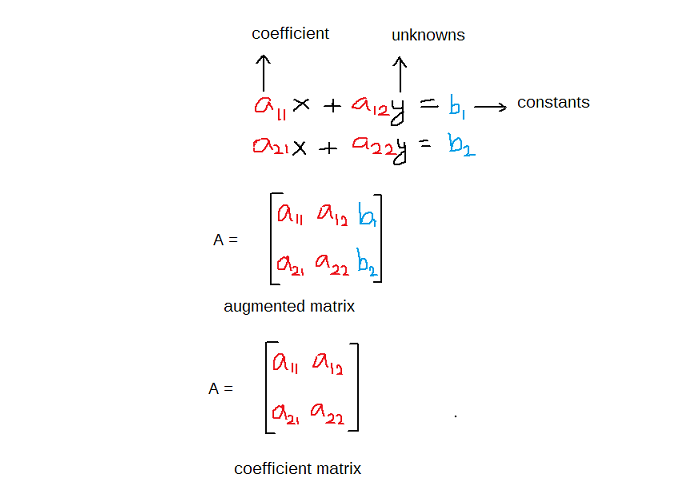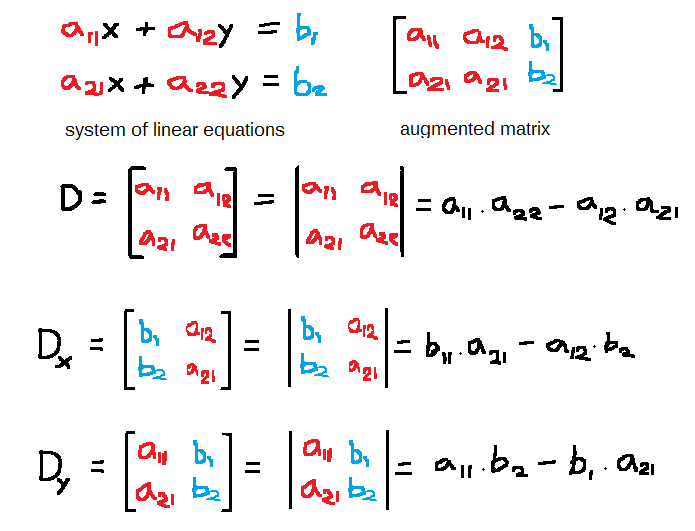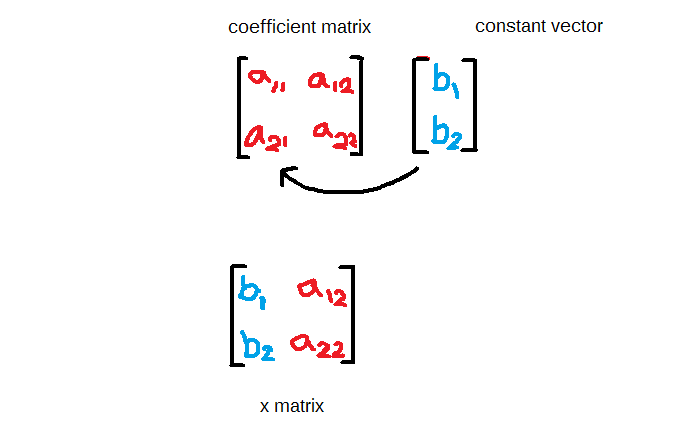Cramer’s rule is a method of solving the system of linear equations using determinants. It is named after Gabriel Cramer (1704–1752) who discovered this method. In this article we are going to discuss and work few examples for solving system of linear equations using Cramer’s rule.
Before you start reading about Cramer’s rule, learn to compute determinant of 2 x 2 and 3 x 3 matrix as a prerequisite to this article : Finding Determinants Using Cross Multiplication.
Coefficient Matrix and Augmented Matrix
Given a system of equation you can derive a coefficient matrix and an augmented matrix from it. Both are the same thing with little different.
Suppose you are given a system of linear equations with 2 unknowns.
\begin{aligned}
&a_{11}x + a_{12}y = b_1\\\\
&a_{21}x + a_{22}y = b_2
\end{aligned}The augmented matrix and coefficient matrix would look like the following.

The system of linear equation is in the form of ![]() which is written as
which is written as
\begin{aligned}
&Ax = b\\\\
&\begin{bmatrix}a_{11} & a_{12}\\a_{21} & a_{22}\end{bmatrix} . \begin{bmatrix}x \\ y\end{bmatrix} = \begin{bmatrix}b_1 \\ b_2\end{bmatrix}
\end{aligned}The matrix ![]() is coefficient matrix,
is coefficient matrix, ![]() is a column vector of unknowns, and
is a column vector of unknowns, and ![]() represents the constant vector.
represents the constant vector.
Determinant Of 2 x 2 Matrix
The determinant of a 2 x 2 matrix can be calculated using cross multiplication.
\begin{aligned}
&A = \begin{bmatrix}a_{11} & a_{12}\\a_{21} & a_{22}\end{bmatrix}\\\\
&|A| = \begin{vmatrix}a_{11} & a_{12}\\a_{21} & a_{22}\end{vmatrix} = a_{11}a_{22} - a{12}.a_{21}
\end{aligned}Example #1
Find the determinant of ![]() .
.
Solution:
|A|= \begin{vmatrix}2 & 1\\3 & 7\end{vmatrix} = 14 - 3 = 11Solving System of Equations with 2 Unknowns With Cramer’s Rule
Given a system of equations with 2 unknowns you can solve it using Cramer’s rule by following steps.
- Find the augmented matrix and the coefficient matrix for the system of equations.
- Find the determinant of
 of matrix
of matrix  .
. - Replace the
 coefficients of coefficient matrix
coefficients of coefficient matrix  with constant vector
with constant vector  to get x-matrix and find its determinant
to get x-matrix and find its determinant 
- Replace the
 coefficients of coefficient matrix
coefficients of coefficient matrix  with constant vector
with constant vector  to get y-matrix and find its determinant
to get y-matrix and find its determinant 
- Find the solution to system of linear equation according to following equations.
\begin{aligned}
&x = D_x/D\\\\
&y = D_y/D
\end{aligned}See the following figure to understand how the matrices look like.

Given a system of equations such as shown above, first derive the augmented matrix and coefficient matrix. The coefficient matrix has no constant vector. Use the coefficient matrix to get the determinant of matrix ![]() which is
which is ![]() .
.
X Matrix And Y Matrix
You can get x matrix by replacing the first column which is x column by the constant vector. See the image below.

Similarly, compute the y matrix from coefficient matrix of ![]() . Compute the determinant of x matrix which is
. Compute the determinant of x matrix which is ![]() and compute the determinant of y matrix which is
and compute the determinant of y matrix which is ![]() .
.
To find the solution to each unknowns use the following formula, mentioned earlier.
Solution for x
\begin{aligned}
&x = D_x/D
\end{aligned}Solution for y,
y = D_y/D
In the next section, we will solve a system of linear equation with two unknown.
Example #1
Find the solution to following system of linear equations with two unknowns using Cramer’s rule.
\begin{aligned}
&x + 3y = 5\\\\
&5x - 2y = 8
\end{aligned}Solution:
Given the system of linear equations we can obtain augmented matrix and coefficient matrix.
A = \begin{bmatrix}1 & 3 & 5\\5 & -2 & 8\end{bmatrix}The coefficient matrix must be a square matrix, so lets write the augmented matrix in the form ![]() in that order.
in that order.
\begin{aligned}
&Ax = b\\\\
&\begin{bmatrix}1& 3\\5 & -2\end{bmatrix} . \begin{bmatrix}x & y\end{bmatrix} = \begin{bmatrix}5 & 8\end{bmatrix}
\end{aligned}Compute the determinant of the matrix ![]() .
.
D = \begin{vmatrix}1& 3\\5 & -2\end{vmatrix} = -2 - 15 = -17 Compute the determinant of the ![]() matrix.
matrix.
D_x = \begin{vmatrix}5 & 3\\8 & -2\end{vmatrix} = -10 - 24 = -34 Compute the determinant of the ![]() matrix.
matrix.
D_y = \begin{vmatrix}1& 5\\5 & 8\end{vmatrix} = 8 - 25 = -17Therefore,
\begin{aligned}
&x = -34/(-17) = 2\\\\
&y = -17/(-17)= 1
\end{aligned}We can verify the solution by substitution.
\begin{aligned}
&(2) + 3(1) = 5\\\\
&5(2) - 2(1) = 8
\end{aligned}The solutions to the system of linear equations are correct.
Solving System Of Equations With 3 Unknowns Using Cramer’s Rule
We can solve the system of equations with 3 unknowns which gives a ![]() square matrix using the Cramer’s rule.
square matrix using the Cramer’s rule.
Though we need to compute the determinant of additional sub-matrices because there is one more unknown other than x and y. Let us call it z.
The steps remain the same as we solved for ![]() matrix. Here is the list of steps.
matrix. Here is the list of steps.
Let ![]() be a
be a ![]() matrix.
matrix.
Step 1: Compute determinant ![]() of
of ![]() .
.
Step 2: You must extract sub-matrices or minors from the matrix ![]() and take determinant
and take determinant